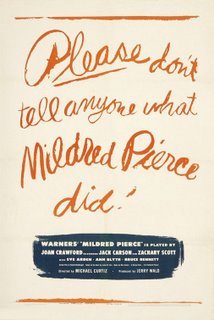I like to play with dolls

If only all mothers defended (the memories of) their sons with such ferocity.
Oh, I'm eternally right. But what good does it do me?

OK, so the eagerly anticipated Notorious Bettie Page isn't so good. This is through no fault of Gretchen Mol, who strives mightily to elevate the material. As someone who in snapshots and stills doesn't look much like Page, Mol employs facial expression and physical movement to channel the pinup icon. (It takes real knowledge to embody the titular naïf so convincingly.) Mol is most effective in re-creations of photo sessions and performances for silent reels. Particularly appealing are moments like those in the cheap little bondage films where, clad in elaborate lingerie and truly punishing heels, she shakes her finger at a naughty, often hog-tied captive. She seems less the dominatrix than a little girl scolding her doll. Unfortunately, such endearing aspects are almost lost in an uninspired story and script. The filmmakers don't do Ms. Mol or Ms. Page any favors by stranding actress and character in a tedious narrative that skips along the surface of what is presumably a more interesting life. The film version of Bettie is like the movie itself: they're not engaging when she's not posing. Especially finger-wagging.

 I know I had promised that the last entry would address noirish melodramas, but I couldn't resist that Trog one-sheet featuring the late, great J.C. (As I've explained to A & L, Norman doesn't worship Jesus Christ.) That exploitation-cheapie poster is not entirely unrelated, as Ms. Crawford happened to star in -- and garnered her only Oscar for -- Mildred Pierce (1945), which may be the most effective blend of key elements of melodrama and film noir.
I know I had promised that the last entry would address noirish melodramas, but I couldn't resist that Trog one-sheet featuring the late, great J.C. (As I've explained to A & L, Norman doesn't worship Jesus Christ.) That exploitation-cheapie poster is not entirely unrelated, as Ms. Crawford happened to star in -- and garnered her only Oscar for -- Mildred Pierce (1945), which may be the most effective blend of key elements of melodrama and film noir.As a general matter, I experience sufficient difficulty slogging through a day of work without writing about it. Every now and then, however, the constant low-level agitation and dread explode into full-fledged Grand Guignol. For instance -- don't blame the messenger! -- this morning, as I was turning into the corridor from our offices, I overheard the tail end of a co-worker's litany of grievances as she and another emerged from the ladies':
"And on top of everything, I got my period. (beat) It stained my underwear."Seriously, God, are you there? Please deliver me from this place. And restore my hearing.

It's depressing to be suffering from this writer's block after only a few entries. The blog form certainly lends itself to a certain mundanity and casualness (what former pop star Jewel refers to as "casualty" in her poetry), but I've never been good at small talk. (Have I told you about all the rain in "sunny" California?) Maybe it's the diary-like intimacy that gives me jitters. (I mean "journal." Journal.) But I don't want my blog to suffer some form of crib death, so I thought I'd check in and share some of my inchoate ideas and failed attempts. Please let me know whether I should move from simple neglect to active infanticide and kill the blog I've sired. (I'm not quitting, but I am given to melodramatic gestures.) Without further ado, here's what's been gestating: